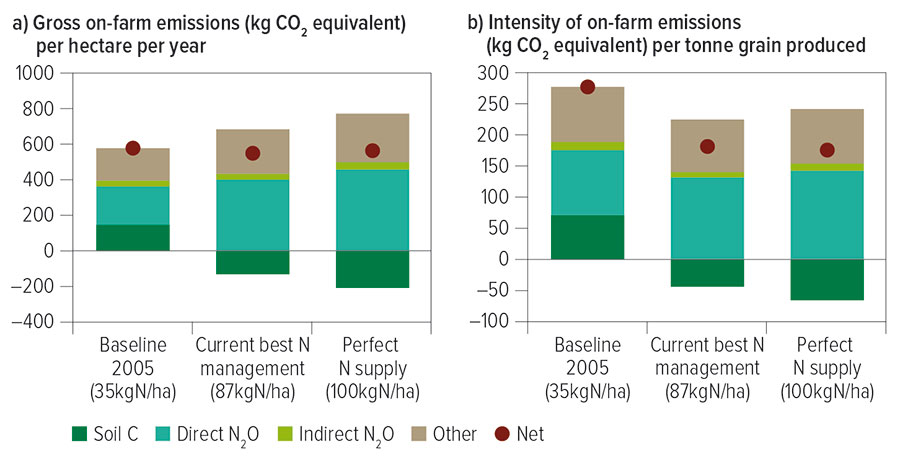By optimising nitrogen efficiency, it is possible to improve financial returns and reduce greenhouse gas emissions per tonne of grain produced.
Key points
- Nitrogen fertiliser use accounts for the largest greenhouse gas emissions in the grains industry
- This represents both a financial and environmental cost
- Fertiliser application practices that improve nitrogen use efficiency have the potential to increase yield and reduce emissions per tonne produced
Nitrogen fertiliser is under the spotlight as the largest source of greenhouse gas emissions in the grains industry. But the imperative to reduce nitrogen fertiliser losses is not just about reducing greenhouse gases, it is also about protecting the bottom line. Fertiliser is simply too expensive to waste.
Greenhouse gas emissions are generated via both the on-farm application of fertiliser and off-farm in the manufacturing and energy sectors. Emissions associated with nitrogen fertilisers account for about 38 per cent of emissions in the grains industry. On-farm losses – particularly losses of nitrous oxide (N2O), a potent greenhouse gas – contribute 15 per cent of emissions, which could potentially be reduced by improving nitrogen management practices.
Using less fertiliser is not the solution. Reducing fertiliser rates reduces yield, mines soil nitrogen and carbon and reduces the ability of the soil to buffer emissions.
Tackling emissions
To evaluate the potential to reduce greenhouse gas emissions from the grains sector, GRDC invested in modelling analysis across every subregion of Australia. The work was led by CSIRO Agriculture and Food in partnership with the NSW Department of Primary Industries.
The analysis found that by improving the efficiency of nitrogen use, growers stand to increase yields and generate a 10 per cent reduction in the intensity of total emissions.
Crop yields, nitrogen losses and soil carbon processes were analysed using the Agricultural Production Systems sIMulator (APSIM) model in locally relevant cropping sequences over a 30-year period from 1990–2019. Modelling allowed the exploration of the impact of different nitrogen management strategies across a broad range of environments and seasonal conditions.
The study compared current industry nitrogen fertiliser practice with application rates based on either a 2005 national average of 38 kilograms of nitrogen per hectare or 2015 average of 58kg/ha against improved nitrogen management scenarios. These included a current best management practice of split application adjusted to seasonal outlook and soil moisture status, or a perfect (but not currently possible) scenario where nitrogen was continually topped up through to flowering to match crop demand.
As expected, increased rates of nitrogen fertiliser led to increased greenhouse gas emissions per hectare (Figure 1a), but grain production increased at a greater rate. This means that the intensity – or emissions per tonne of grain production – decreased (Figure 1b).
Figure 1: National APSIM modelling simulations showed that increasing nitrogen rates increased the gross on-farm emissions per hectare – particularly nitrous oxide (N2O) – but as yield and biomass also increased, this was offset by reduced emissions through soil carbon loss (1a). More importantly, increased grain yield led to a net reduction in emissions intensity per tonne of grain produced (1b).

Source: Dr Lindsay Bell, CSIRO
Nitrogen and carbon trade-offs
Increasing the rate of nitrogen application also generated more crop biomass, which meant that increased nitrous oxide emissions were offset by lower soil carbon emissions and in some cases by carbon fixation (Figure 1a).
Although the results were highly variable depending on seasonal conditions, the trend was consistent over a 30-year period, albeit with some regional differences.
While different rotations were explored in the analysis, further work is required to understand the impact of increasing nitrogen-fixing legume crops and pastures, or green manures on total emissions and emissions intensity.
However, one thing is clear: to maintain a productive grains industry and feed the world, it is vital to optimise yield gains in the seasons where it is possible, as efficiently as possible.
More information: Dr Maartje Sevenster, maartje.sevenster@csiro.au; Lindsay Bell, 0409 881 988, lindsay.bell@csiro.au, Greenhouse gas emissions

























































